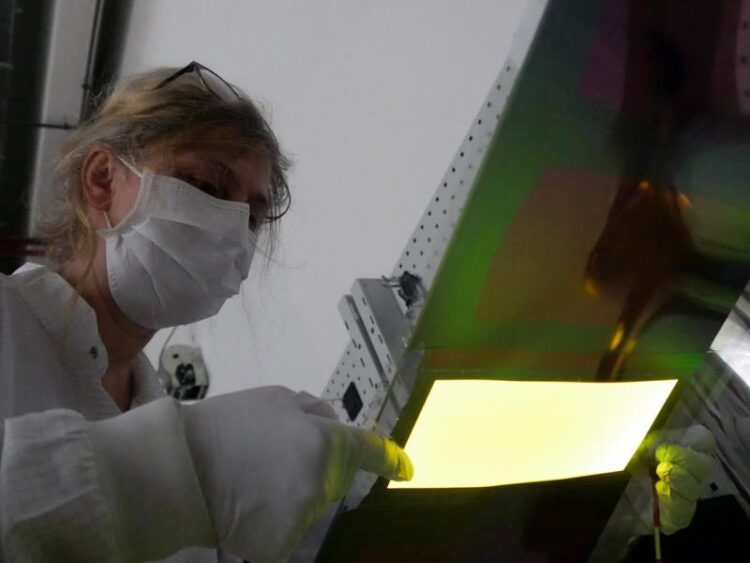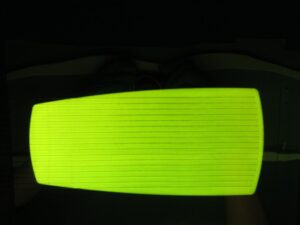Flexible OLED for homogeneous light in the operating room

Initial inspection of an OLED after Roll-to-Roll processing and before laser singulation
© Fraunhofer FEP; Picture in printable resolution: www.fep.fraunhofer.de/press
Within the joint project LAOLA, which was funded by the German Federal Ministry of Education and Research (BMBF) and has now been completed, large-area lighting applications with OLEDs on flexible substrates should be developed. The project focused on ultra-thin glass, which offers advantages compared to plastic as a substrate due to its excellent barrier properties. At the Fraunhofer FEP, the OLEDs were applied to the flexible glass using a roll-to-roll process. A surgical light designed using this process will be presented at LOPEC 2022, on March 23 and 24, 2022, in Munich, at the joint booth of the project coordinator Organic Electronics Saxony e.V. (OES), No. B0.308.

© Fraunhofer FEP; Picture in printable resolution: www.fep.fraunhofer.de/press
The glare-free, homogeneous light of large-area organic light-emitting diodes (OLEDs) is perceived as very pleasant and offers many advantages for product design. In the recently completed LAOLA project, OLEDs were therefore developed as planar lighting for a wide range of applications on flexible substrates. The project focused on flexible ultra-thin glass, which offers advantages over plastic as a substrate due to its excellent barrier properties. Some of the technologies were researched as part of the internationalization project between Japan and Germany associated with LAOLA with cooperation partners from the Japanese partner cluster YUFIC at Yamagata University. In particular, the establishment of flexible ultra-thin glass as a substrate was advanced here.
In order to consider suitable applications in addition to technological developments, WOLFRAM Designers and Engineers (WDI) worked out a concrete area of application for OLED on ultra-thin glass. This was implemented in the form of a surgical light, which combines large OLED luminous surfaces with LED spotlights in its shape design. The OLEDs are installed as wing elements and provide indirect, glare-free illumination, while the LED spotlights enable direct illumination.
German-Japanese cooperation for expertise on ultra-thin glass technologies
A number of other partners collaborated to produce the actual OLED on ultra-thin glass. The beginning of this value chain is Nippon Electric Glass Co., Ltd. (NEG) as a manufacturer of ultra-thin glass rolls. At Yamagata University a transparent conductive oxide (TCO) was deposited on the ultra-thin glass with a width of 300 millimeters for further processing as the anode material for the OLED. However, the sheet resistance of ~30 ohms per square meter is not sufficient to homogeneously illuminate the entire luminous area of 206 × max. 95 mm². To solve this, thin gain lines were printed. This was done on a roll-to-roll screen printing system at Yamagata University in collaboration with the company SERIA ENGINEERING, INC. (roll-to-roll screen printing process) and Fujikura Kasei Co., Ltd. (printing paste manufacturer).
New technologies for evaporation, cutting and structuring processes
“Ensuring the long-term stability of the OLED devices and the hygienic surface of the luminaire played a key role in the selection of ultra-thin glass as a substrate,” explains Dr. Jacqueline Hauptmann, a scientist at Fraunhofer FEP. “One focus of the project was the retrofit of an existing roll-to-roll vacuum coating system at Fraunhofer Institute for Organic Electronics, Electron Beam and Plasma Technology FEP to easily wind, coat and encapsulate pure ultra-thin glass of 50 and 100 micrometers thickness with strip tensions in the range of 30 – 50 newtons. The retrofit of the plant was successfully carried out by the company FHR Anlagenbau GmbH.”
For the deposition of thin metal layers in a roll-to-roll process for anode and cathode coating, the metal evaporator was converted by the project partner CREAVAC-Creative Vakuumbeschichtung GmbH. This allowed calcium and silver to be evaporated simultaneously to achieve transparent layers of 8 nanometers thickness (calcium/silver ratio 1:7) over a width of 290 millimeters with a layer thickness variation of ~1%.
The necessary laser cutting and structuring processes for the separation and interconnection of the OLEDs proved to be a further challenge. Together with the project partner Heliatek GmbH, an alternative structuring method was developed that has enormous potential for subsequently structuring already completed devices with low particle counts. For this purpose, the anode, which is covered with a printed passivation, is lasered through the ultra-thin glass. Furthermore, the use of thermally evaporated melamine was validated in the project and advanced with the project partners Creaphys GmbH and Heliatek GmbH. Both technologies have enormous potential for use in new fields of application in flexible organic electronics.
Results ready for technology transfer to industry
The final separation of the OLED could be successfully developed within the project with the project partner 3D-Micromac AG. With the help of a laser equipped with Bessel optics, the so-called filamentation of the ultra-thin glass on both sides on the substrate and encapsulation side and a subsequent mechanical separation of the adhesive could be demonstrated. Cutting speeds of 400 millimeters per second were achieved. From the project partner tesa SE, different adhesive tapes for encapsulation in the thin glass laminate, also with water trap components, were tested and the cut glasses and glass-adhesive-glass laminates were examined for mechanical strength.
A flexible stainless steel film from NIPPON STEEL Chemical & Material CO., LTD was tested for the encapsulation of opaque OLED devices. The 30 micrometer thin film can be processed very well by roll-to-roll method and holds prospects of being a promising alternative to ultra-thin glass encapsulation due to its more favorable temperature management. The separation of the glass-adhesive-stainless steel OLED was carried out here by Mitsuboshi Diamond Industrial Co, Ltd (MDI).
In addition to project coordination, Organic Electronics Management GmbH has prepared a market study for the lead applications developed by WDI, as well as a manufacturing concept, paving the way for technology transfer by the partners. Dr. Jonas Jung, project manager at OES, says: “By applying innovative production technologies across all partners, a promising OLED demonstrator has been developed, opening up new application possibilities for flexible electronics. This great result of the LAOLA project underlines the innovative power of the long-standing German-Japanese collaboration.”
The results obtained in the three-year LAOLA project (2018 – 2021) can be directly transferred to other existing roll-to-roll tape lines. The successful separation of OLED modules from the bonded glass-glass composite, which was in a rolled-up state after processing, can also be easily transferred in the future.
We thank the German Federal Ministry of Education and Research (BMBF) for the support in the LAOLA project (Large-area OLED lighting applications on thin flexible substrates, funding code 03INT509A), as well as all German and Japanese project partners.
About the project:
Large Area OLED Lighting Applications on ultra-thin flexible Substrates (LAOLA)
Funding program of the Federal Ministry of Education and Research: Internationalization of Leading-Edge Clusters, Future Projects and Comparable Networks
Funding reference: 03INT509AF
Project duration: 01.08.2018 to 31.12.2021
Website: https://oes-net.de/projekt/laola/
Project partners:
Organic Electronics Saxony Management GmbH (coordinator)
Fraunhofer FEP
FHR Anlagenbau GmbH
CREAVAC-Creative Vakuumbeschichtung GmbH
WOLFRAM Designer und Ingenieure
Heliatek GmbH
Associated partners:
3D-Micromac AG
CreaPhys GmbH
Tesa SE
Press contact:
Mrs. Annett Arnold
Fraunhofer Institute for Organic Electronics, Electron Beam and Plasma Technology FEP
Phone +49 351 2586 333 | presse@fep.fraunhofer.de
Winterbergstraße 28 | 01277 Dresden | Germany | www.fep.fraunhofer.de
Weitere Informationen:
Media Contact
All latest news from the category: Materials Sciences
Materials management deals with the research, development, manufacturing and processing of raw and industrial materials. Key aspects here are biological and medical issues, which play an increasingly important role in this field.
innovations-report offers in-depth articles related to the development and application of materials and the structure and properties of new materials.
Newest articles

Innovative 3D printed scaffolds offer new hope for bone healing
Researchers at the Institute for Bioengineering of Catalonia have developed novel 3D printed PLA-CaP scaffolds that promote blood vessel formation, ensuring better healing and regeneration of bone tissue. Bone is…

The surprising role of gut infection in Alzheimer’s disease
ASU- and Banner Alzheimer’s Institute-led study implicates link between a common virus and the disease, which travels from the gut to the brain and may be a target for antiviral…

Molecular gardening: New enzymes discovered for protein modification pruning
How deubiquitinases USP53 and USP54 cleave long polyubiquitin chains and how the former is linked to liver disease in children. Deubiquitinases (DUBs) are enzymes used by cells to trim protein…



